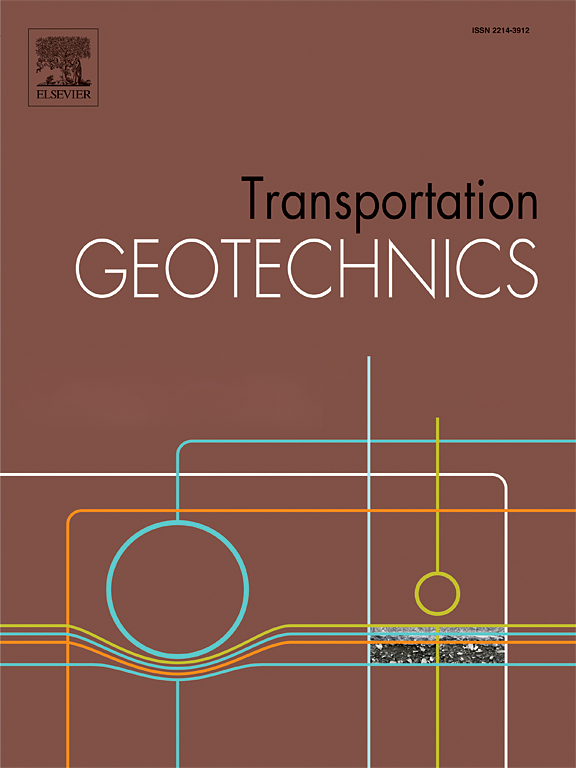土工格栅稳定路面永久变形响应评估的机器学习技术
IF 4.9
2区 工程技术
Q1 ENGINEERING, CIVIL
引用次数: 0
摘要
减小永久变形(即抗车辙能力)和提高刚度是土工格栅稳定路面的两个关键特征。此外,土工格栅还有助于在大范围内保持刚度分布的均匀性,证明了稳定提供的更高可靠性。在大多数常见的路面设计和评估方法中,永久变形是长期路面性能评估的重要组成部分。例如,AASHTO(美国国家公路运输官员协会)R50标准在计算交通效益比(TBR)或基线减径(BCR)系数时考虑了永久变形。虽然全面加速路面测试或在役路面测试是评估永久变形响应的理想方法,但这种测试可能不适用于各种情况,包括不同的路基类型、气候区和材料类型。另一种方法是使用大型板载荷测试来进行原位材料表征。自动化板载测试(APLT)是一种基于现场的板载测试系统,用于施加动态载荷并测量永久和弹性变形。在本文中,应用aplt测量了由不同集料基层(ABC)厚度、ABC材料类型、多轴土工格栅和路基条件组成的几个路面路段的永久变形。探讨了多种机器学习技术,包括多元线性回归分析(MLRA)、基因表达编程(GEP)、定制非线性回归(CNR)、传统机器学习(TML)和人工神经网络(ANN),以建立永久性变形的预测模型。在TML模型中,Extra Tree、XGBoost和LightGBM对过拟合的准确性和鲁棒性都较好。这些模型有效地捕捉了模型参数之间复杂的相互作用,使其适用于评估土工格栅稳定路面。本文章由计算机程序翻译,如有差异,请以英文原文为准。
Machine learning techniques for evaluation of permanent deformation responses from geogrid stabilized pavements
Permanent deformation reduction (a.k.a., rut resistance capacity) and stiffness improvement are two key features of geogrid stabilized pavements. Furthermore, geogrids also contribute to preserving the uniformity of the stiffness distribution over a wide area, proving the increased reliability provided by stabilization. In most common pavement design and evaluation methodologies, permanent deformation is an essential component for long-term pavement performance assessment. For example, the AASHTO (Association of State Highway Transportation Officials) R50 standard considers permanent deformation for the derivation of the traffic benefit ratio (TBR) or base course reduction (BCR) factor. Although full-scale accelerated pavement testing or in-service pavement testing is ideal for assessing permanent deformation responses, such testing may not be feasible to perform in a wide range of situations, including diverse subgrade types, climatic zones, and material types. An alternative is to use large-scale plate load testing for in-situ material characterization. Automated Plate Load Testing (APLT) is a field-based plate load testing system for applying dynamic loads and measuring permanent and resilient deformations. For this paper, APLTs were conducted to measure permanent deformations on several pavement sections consisting of different aggregate base course (ABC) thicknesses, ABC material types, multi-axial geogrids, and subgrade conditions. Several machine learning techniques, including Multiple Linear Regression Analysis (MLRA), Gene Expression Programming (GEP), Customized Non-linear Regression (CNR), Traditional Machine Learning (TML), and Artificial Neural Networks (ANN), were explored to develop prediction models for permanent deformation. Among the TML models, Extra Tree, XGBoost, and LightGBM demonstrated superior accuracy and robustness against overfitting. These models effectively captured the complex interactions between model parameters, making them suitable for evaluating geogrid-stabilized pavements.
求助全文
通过发布文献求助,成功后即可免费获取论文全文。
去求助
来源期刊

Transportation Geotechnics
Social Sciences-Transportation
CiteScore
8.10
自引率
11.30%
发文量
194
审稿时长
51 days
期刊介绍:
Transportation Geotechnics is a journal dedicated to publishing high-quality, theoretical, and applied papers that cover all facets of geotechnics for transportation infrastructure such as roads, highways, railways, underground railways, airfields, and waterways. The journal places a special emphasis on case studies that present original work relevant to the sustainable construction of transportation infrastructure. The scope of topics it addresses includes the geotechnical properties of geomaterials for sustainable and rational design and construction, the behavior of compacted and stabilized geomaterials, the use of geosynthetics and reinforcement in constructed layers and interlayers, ground improvement and slope stability for transportation infrastructures, compaction technology and management, maintenance technology, the impact of climate, embankments for highways and high-speed trains, transition zones, dredging, underwater geotechnics for infrastructure purposes, and the modeling of multi-layered structures and supporting ground under dynamic and repeated loads.
 求助内容:
求助内容: 应助结果提醒方式:
应助结果提醒方式:


